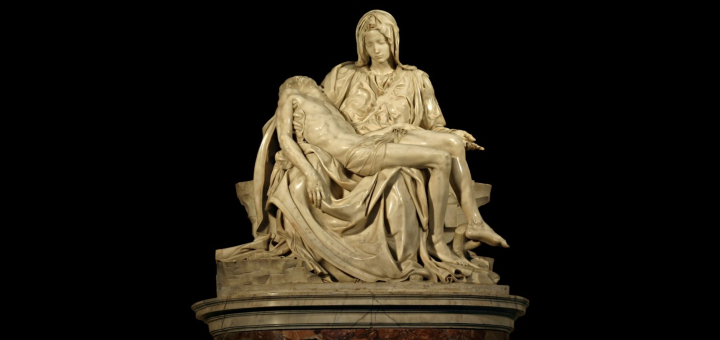
 By Stanislav Traykov, Niabot (cut out) - Image:Michelangelo's Pieta 5450.jpg, CC BY 2.5, Wikimedia Commons[/caption]
Michelangelo’s Pietà, is one of the most well-known and well-loved artworks to have come out of the Italian Renaissance. When it was first revealed in 1499 it was immediately recognized as a masterpiece, in part because the unknown Michelangelo was only in his early twenties when he carved it. The marble sculpture had been created as a funeral monument (tomb sculpture) for a French cardinal. The sculpture remained so popular, however, that 300 years later the Vatican moved the Pietà to its current place inside the main basilica.
The sculpture stands over five feet tall, a standard size for a Renaissance sculpture, but an extremely unusual size for the subject matter. The pieta scene depicts Mary holding the body of her Son; similar artwork dates back to medieval Europe. But these would have been small wooden devotionals (small statues for private prayer) which were rarely larger than a foot tall. Michelangelo changed all of that with his larger-than-life sculpture.
But what makes this sacred artwork so unique is that the pieta is not a scene based on scripture – it was purely an artistic creation. So why does it continue to inspire awe and devotion? The beauty and power behind Michelangelo’s creation is the ability to capture the physical suffering of Christ and the emotional suffering of Mary.
By Stanislav Traykov, Niabot (cut out) - Image:Michelangelo's Pieta 5450.jpg, CC BY 2.5, Wikimedia Commons[/caption]
Michelangelo’s Pietà, is one of the most well-known and well-loved artworks to have come out of the Italian Renaissance. When it was first revealed in 1499 it was immediately recognized as a masterpiece, in part because the unknown Michelangelo was only in his early twenties when he carved it. The marble sculpture had been created as a funeral monument (tomb sculpture) for a French cardinal. The sculpture remained so popular, however, that 300 years later the Vatican moved the Pietà to its current place inside the main basilica.
The sculpture stands over five feet tall, a standard size for a Renaissance sculpture, but an extremely unusual size for the subject matter. The pieta scene depicts Mary holding the body of her Son; similar artwork dates back to medieval Europe. But these would have been small wooden devotionals (small statues for private prayer) which were rarely larger than a foot tall. Michelangelo changed all of that with his larger-than-life sculpture.
But what makes this sacred artwork so unique is that the pieta is not a scene based on scripture – it was purely an artistic creation. So why does it continue to inspire awe and devotion? The beauty and power behind Michelangelo’s creation is the ability to capture the physical suffering of Christ and the emotional suffering of Mary.
 By Stanislav Traykov - This file was derived from: Michelangelo's Pieta 5450.jpg, CC BY 2.5, Wikimedia Commons[/caption]
Originally I was going to discuss how this artwork leads us into the Easter season, but with the sudden threat of COVID-19, I have decided to go in another direction. Michelangelo’s Pietà after all, is not just a famous masterpiece, it is a devotional Christian artwork.
Throughout the Middle Ages and the Renaissance, Europe was constantly under threat from war, starvation and illness. The bubonic plague would terrify Europe for nearly 600 years, wiping out cities and even countries with the deadly disease. In a time before modern nutrition, hygiene and medicine, people’s only relief was through prayer. In a time where death was widespread, people gravitated towards images that were similar to their own lives. It is perhaps not a surprise that medieval artists created devotional artworks depicting Christ’s Passion. While it may seem morbid to us today, Christ’s suffering offered solidarity in an uncertain world.
By no means am I implying that is where we are at today, but COVID-19 has impacted our society in a way that has not been seen in a very long time. Medieval people did not have the luxuries of medicine and technology that we have today, but that does not mean we should forget about prayer.
The Pietà is one of the most recognizable and enduring Christian symbols in history for a reason. It is a sorrowful scene, but one that also holds the promise of hope and redemption. We should still find comfort in Mary’s presence. After all, it is Mary who always hears our prayers and intercedes for us on behalf of her son.
What Michelangelo carved out of marble was not just the angelic features of Mary, but the hope and comfort she offers to us as a mother. It is easy to imagine that her loving gaze is directed at us, and that she is offering her motherly love and protection to the world. This sculpture is a reminder of Mary’s faith in God, and her hope for mankind.
Mary’s gaze is downcast, but she has not been defeated by the death of her son. There is strength and serenity within her which she now offers to us. After all, Mary is not only the Mother of Christ, she is the mother to all who believe in him.
In the weeks to come, whatever they may hold, please stay strong. And always know that Mary is listening to our prayers and holding them close to her heart.
By Stanislav Traykov - This file was derived from: Michelangelo's Pieta 5450.jpg, CC BY 2.5, Wikimedia Commons[/caption]
Originally I was going to discuss how this artwork leads us into the Easter season, but with the sudden threat of COVID-19, I have decided to go in another direction. Michelangelo’s Pietà after all, is not just a famous masterpiece, it is a devotional Christian artwork.
Throughout the Middle Ages and the Renaissance, Europe was constantly under threat from war, starvation and illness. The bubonic plague would terrify Europe for nearly 600 years, wiping out cities and even countries with the deadly disease. In a time before modern nutrition, hygiene and medicine, people’s only relief was through prayer. In a time where death was widespread, people gravitated towards images that were similar to their own lives. It is perhaps not a surprise that medieval artists created devotional artworks depicting Christ’s Passion. While it may seem morbid to us today, Christ’s suffering offered solidarity in an uncertain world.
By no means am I implying that is where we are at today, but COVID-19 has impacted our society in a way that has not been seen in a very long time. Medieval people did not have the luxuries of medicine and technology that we have today, but that does not mean we should forget about prayer.
The Pietà is one of the most recognizable and enduring Christian symbols in history for a reason. It is a sorrowful scene, but one that also holds the promise of hope and redemption. We should still find comfort in Mary’s presence. After all, it is Mary who always hears our prayers and intercedes for us on behalf of her son.
What Michelangelo carved out of marble was not just the angelic features of Mary, but the hope and comfort she offers to us as a mother. It is easy to imagine that her loving gaze is directed at us, and that she is offering her motherly love and protection to the world. This sculpture is a reminder of Mary’s faith in God, and her hope for mankind.
Mary’s gaze is downcast, but she has not been defeated by the death of her son. There is strength and serenity within her which she now offers to us. After all, Mary is not only the Mother of Christ, she is the mother to all who believe in him.
In the weeks to come, whatever they may hold, please stay strong. And always know that Mary is listening to our prayers and holding them close to her heart.
Copyright 2020 Caleigh McCutcheon
About the Author

Caleigh McCutcheon
Caleigh McCutcheon is the curator at the Museum of Family Prayer in North Easton, MA. She has a BA in English from Stonehill College and a MA in Art History from Glasgow University. Her Master’s thesis focused on the complexity and lasting power of the Pieta image in Christian art. She considers art to be one of the most powerful forms of prayer.


.png?width=1806&height=731&name=CatholicMom_hcfm_logo1_pos_871c_2728c%20(002).png)
Comments